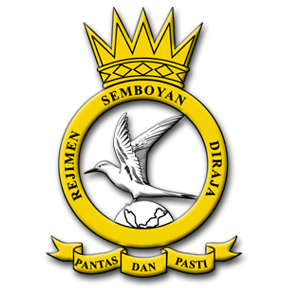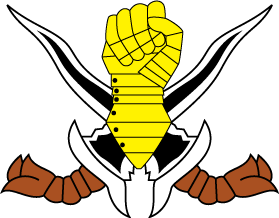
The Royal Ranger Regiment is an infantry regiment of the Malaysian Army. Although it is second in seniority to the Royal Malay Regiment, the RRD can trace its origins back to the mid 19th century and the establishment of The Sarawak Rangers, the peacekeeping force in the Sarawak region. This force was absorbed by the Sarawak Constabulary in 1932, but the name was revived in 1941 as a British Colonial unit; this unit commanded by British Lieutenant Colonel C.M. Lane was captured by the Japanese in 1942.

The Malaysian Army is the land component of the Malaysian Armed Forces. Steeped in British Army traditions, the Malaysian Army does not carry the title ‘royal’ as do the Royal Malaysian Navy and the Royal Malaysian Air Force. Instead, the title is bestowed on selected army corps and regiments who have been accorded the honour by the Yang di-Pertuan Agong, who is the Supreme Commander of the Malaysian Armed Forces.
The Star of the Commander of Valour is a medal awarded by the Malaysian government. The award was established on 29 July 1960, and it was formally gazetted by an act of parliament on 11 August 1960. It is Malaysia's second highest gallantry award, coming in second only to the Grand Knight of Valour.

The Rejimen Askar Wataniah is the military reserve force of the Malaysian Army.

The Rejimen Artileri DiRaja is the artillery corps of the Malaysian Army. Rejimen Artileri DiRaja was formed in Kajang on 15 August 1957 when a single battery was formed, drawn from Malay personnel formerly serving with the British Army's Royal Regiment of Artillery. Today Rejimen Artileri DiRaja is a modern fighting arm providing direct fire support to Malaysian Army units using field artillery pieces and MLRS.

The Rejimen Semboyan Diraja is a combat support regiment of the Malaysian Army. It has the primary responsibility of establishing and maintaining secure military communications channels for the command and tactical elements of the Malaysian Army. It is also responsible for all electronic support, electronic warfare and early warning system for the Malaysian Army.
Royal Army Engineers Regiment is a group combat support military units of the Malaysian Army that provides combat engineering and other engineering support to the Malaysian Army.

The Kor Polis Tentera DiRaja is the military police branch of the Malaysian Army. Referred to as the "Redcaps" like their British counterpart or, more popularly, known as "MPs", the Kor Polis Tentera DiRaja keep discipline within the Army ranks and ensure security at Malaysian Army installations.

Gerak Khas, or Grup Gerak Khas, also spelled Gerakhas, is a Malaysian Army special forces unit that performs special operations missions such as direct action, unconventional warfare, sabotage, counter-terrorism, and intelligence gathering. Gerak Khas was founded in 1965 during the Indonesia-Malaysia conflict, and they gained worldwide fame and recognition after successfully pacifying the communist insurgency in Malaysia's jungles between 1968 and 1989.

The Royal Armoured Corps or Kor Armor Diraja (KAD) is the armoured forces of the Malaysian Army.
Malaysia's armed forces, which encompasses three major branches, originate from the formation of local military forces in the first half of the 20th century, during British colonial rule of Malaya and Singapore prior to Malaya's independence in 1957. The branches have undergone several restructuring, but fundamentally includes the army, navy and air force.

The Pasukan Khas TUDM – it is better known as PASKAU – is the special operations force of the Royal Malaysian Air Force. Its main functions are to carry out high-value target protection, ground forward air controller, combat search and rescue and rescuing downed aircrew assignments. PASKAU is also tasked as the principal anti-hijack response force for military and civil aircraft in Malaysia. This task was taken over from Grup Gerak Khas. All PASKAU members are airborne and commando-trained and can be deployed behind enemy lines via air, land and sea to assist in target designation for the Malaysian Armed Forces and RMAF missions. The PASKAU Headquarters is known as RMAF Regiment.

The Ministry of Defence, abbreviated MINDEF, KEMENTAH, is a ministry of the Government of Malaysia that is responsible for defence, national security, army, navy, hydrography, air force, armed forces, intelligence services, counterintelligence, military intelligence, national service, and veterans affairs.

The Special Warfare Training Centre is a Malaysian Army training centre located at the Sungai Udang Camp in Malacca. The primary purpose is to provide basic commando courses and specialised courses and training for personnel from the 21st Special Service Group, 10th Parachute Brigade, and elite units of the Malaysian Armed Forces (MAF) to strengthen the Malaysian defensive garrison against enemies and terrorists.

The Malaysian Army Training and Doctrine Command, known as PL&DTD and PLDTD, is a military command in charge of all Malaysian Army training centres, facilities and museum.
The Special Forces and Elite Forces include both a specially and higher trained unit and a small percentage of personnel from a specific Malaysian military branch, law enforcement or government agency. In Malaysia, the term 'Special Forces' is widely used by uniformed services for special forces, special operations forces and 'special' trained units while 'Elite Forces' for units that more trained and capable combat. Regular personnel must undertake specialized and higher training to be able to join the units of the 'Special and Elite Forces'. These 'Special and Elite Forces' are denoted by different beret colours, shoulder tabs, unit patches, skill badges and uniforms.

The 8th Battalion (Parachute), Royal Ranger Regiment (Malay: Batalion ke-8 Rejimen Renjer Diraja (Para)), better known as the 8 RRD or 8 RRD (Para) – abbreviation from its local name, is a battalion-sized airborne infantry from the Royal Ranger Regiment of the Malaysian Army. On 10 October 1994 the 8 RRD became part of the 10th Parachute Brigade. The 8 RRD is the first infantry unit in the Malaysian Army transformed from a conventional to an airborne unit.
The 9th Battalion (Parachute), Royal Malay Regiment (Malay: Batalion ke-9, Rejimen Askar Melayu Diraja (Payung Terjun)), abbreviated 9 RAMD (Para) from its local name, is a battalion-sized airborne infantry unit of the Malaysian Army's Royal Malay Regiment. Since 10 October 1994, 9 RAMD has been a part of the 10th Parachute Brigade.
The 21st Special Service Group is a command for Malaysian Army special forces, the Gerak Khas. The 21 SSG and 10th Parachute Brigade are elite fighting formations of the Malaysian Army. Both units are independent units under the Malaysian Army and report directly to the Chief of Army. The headquarters of the 21 SSG are at Iskandar Camp in Mersing, Johor.

The 11th Strategic Division, stylized XI Division, was a division-sized combat formation of the Malaysian Army.















